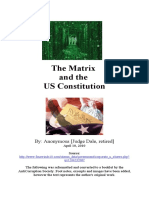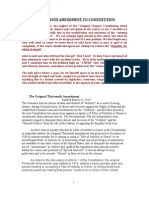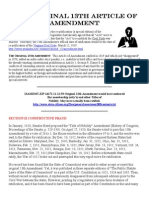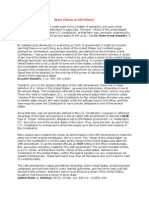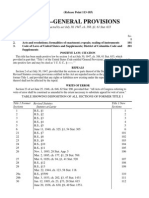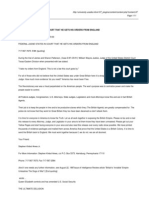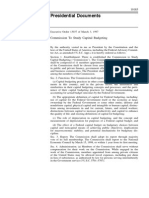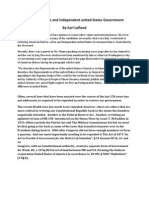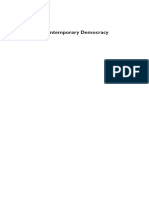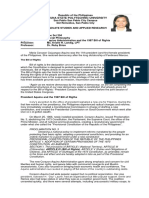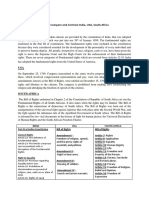United States Corp Vs United States of America
United States Corp Vs United States of America
Uploaded by
doctorfingertips8529Copyright:
Available Formats
United States Corp Vs United States of America
United States Corp Vs United States of America
Uploaded by
doctorfingertips8529Original Title
Copyright
Available Formats
Share this document
Did you find this document useful?
Is this content inappropriate?
Copyright:
Available Formats
United States Corp Vs United States of America
United States Corp Vs United States of America
Uploaded by
doctorfingertips8529Copyright:
Available Formats
Independence Day On the Fourth of July 1776, we were at war, or rather this nation had just ended a war,
and we were for the first time an independent nation. But what did it mean? What does it mean now? - Independence. This nation was one of Englands colonies for hundreds of years and in that time had grown to become one of Englands most productive colonies. Though the Magna Carta was in place the rights of the colonists were continually violated. It became necessary to stop Englands abuse of the colonists rights so ultimately the Declaration of Independence was drafted. In response the King of England doubled the sales tax to the colonies from 3% to 6%. Rather than paying the increased tax some of the colonists had a party and threw a load of tea into the harbor (the Boston Tea Party). The colonists went to war over - the last straw a tax hike on tea. That caused them to have to follow through with the Declaration of Independence. When the War was over they formed a new nation with a foundational document, The Articles of Confederation, that document recognized this nation as a nation made up of independent sovereign united States, and gave the name to the new nation as: "The United States of America". Many of the people of this new nation felt that it was wrong to leave England. Sure there were rights violations but those were livable and their future was a certainty as an English Colony. Now that they were on their own nothing at all was sure. Over the next ten years conditions in this country continually got worse. The individual States gave little regard to any other State and paid nearly no attention at all to the central government. After ten years of independence from England conditions were far worse than they had ever been under Englands rule and protection. Many wanted government officials to go back to England and beg the King to take us back, and they almost did. "To form a more perfect Union" That movement was considered too severe to take without first attempting to resolve the problems of this new nation by the sitting of what later became known as the Constitutional Convention. Each of the Sovereign States gave authority to a few men to, in convention, review the present form of government as set in the Articles of Confederation and to rewrite those Articles so as to eliminate the errors of their present government. In other words those few men were entrusted with the peoples authority to reform the government. A Trust document was there created by the peoples representatives from twelve of the United States. The document had no name, and began simply as follows: "We the People of the united States, in Order to form a more perfect Union, establish Justice, insure domestic
Tranquility, provide for the general Welfare, and secure the Blessings of Liberty to ourselves and our Posterity, do ordain and establish this Constitution for the United States of America." Continuing with VII Articles and concluding with the signatures of the representative of the twelve States present at the convention. Once agreed to and signed by the individual States representatives at the convention, the Trust was formed. The Trust document, with the intent and authority of the people created a "Constitutional Republic" form of government in trust. Though the Trust document had no specific title, the leading paragraph named it: "this Constitution for the United States of America". On, September 17th, 1787, it was resolved by the Convention to take the Trust to the individual States for ratification. The States conditionally turned the Trust down because it removed their sovereignty and didnt secure mans God given inherent rights, without which the States would not give up their sovereignty to support the Constitution. Remember, these individual States were recognized as individual Sovereign States in the Articles of Confederation. That was the problem with the Articles of Confederation, there was no accountability over the individual States. Without accountability whoever was in power simply ignored the central government and moved forward however they saw fit, in violation of individual rights, or not, literally however they saw fit. In essence, they were each literally absolutely powerful kingdoms. It was obvious that if something wasnt done to unite the Union of States as a, "United States" they would be destroyed from within or without. So when offered the Trust document, the individual sovereign States leaders could see that they would no longer be sovereign if they accepted the Trust, and they would be destroyed if they didnt accept it. Not much of a choice, but the war with England ended only a little over ten years earlier and they didnt want to go back, so they demanded that if they were to give up their sovereignty, the peoples rights must be preserved from the central government. Thus they conditionally refused the Trust until the insisted on "Bill of Rights" were added. Therefore, the Trust document was first created to create a Trust known as the "United States". The Trust created a government controlled by the Trust. Government officials were set up within the Trust as Trustees with specific defined responsibilities and functions. The People were set up as the beneficiaries of the Trust and when any government official takes office he/she is required to swear an oath of allegiance [make a contract with the people to uphold the Constitution]. Remember, at this point the government has already been created in trust, by the signed Constitution. As yet the Trust has nobody sitting in the offices of government, however, the States are not willing to support the Trust and authorize its officers to function with control over them unless the peoples rights and the States rights are secured.
The Conventioneers went back to work to draft the requested, Bill of Rights, which were later provided as the First Ten Amendments to the, Constitution of the United States of America, a document that was created to bind officers in an Oath to uphold the Trust of the people and securing the peoples rights. Then the Trust, the Constitution for the United States of America (still signed and unchanged from its original version as first presented to the states), along with the "Bill of Rights" as the first ten amendments to the Constitution of the United States of America, were returned to the individual States and were ratified by each of those States and returned to the Constitutional Convention where the new government was made effective and put in operation on or after, December 15th, 1791, the "Effective date of the Constitution which was then re-written with the Title, The Constitution of the United States of America, including the Bill of Rights. Now lets go back and again review the documents created in the process by name. (Names are about to become very important when we go to the next step and begin to follow the money.) Heres what happened step by step. First: There was the Trust, it had no named Title but within its own first paragraph it named itself the, "Constitution for the United States of America". Remember this document is a Trust document; It created a Trust called the "United States of America". This document was accepted and signed by all of the Conventioneers. The signed Trust document (Constitution) created a government. There was nobody sitting in the seats of that government, and there wouldnt be until such time as the individual States ratified the Constitution and the Conventioneers appointed people into the offices. Second: The Trust was sent out for ratification of the individual States. Third: The individual States declined for a conditional reason which when resolved would make the Trust acceptable. Fourth: The Constitutional Convention again sat and generated the Bill of Rights (a set of supreme laws that limit government). The wording of the Bill recognized it as "Articles in addition to, and Amendment of the Constitution of the United States of America". Presupposing that the Constitution [Trust] already exists. The Constitution was a trust document that created a republican form of government in trust of, by, and for the people.
Note: They did not regenerate the Constitution it was already signed and accepted by each of the States representatives as the Trust that it is. Fifth: The individual States were given the Constitution as before along with the new "Bill of Rights" and all accepted and ratified the documents. Sixth: With the ratification of the Trust and its "Bill of Rights", the government was accepted as formed, in trust, yet still, there were no officers in the seats of the government. [Its very important for us to notice this status of the government.**] Seventh: The Constitutional Convention again sat to perform their final acts as the Creator of the Trust. They appointed officials to sit in the primary seats of the newly formed Constitutional Republic and serve until an election was held. Eighth: Those officials now appointed could not take office until they each individually first swore an Oath of Office stating they would uphold the, Constitution of the United States of America. Again please note the name used in the Bill or Rights and now used for this "contract" by Oath to uphold the: Constitution of the United States of America, not, "for the united", but "of the United". Note: Its important to note here that we are indeed talking about two different documents. The First, the, Constitution for the United States of America, is a Trust and the Second, the, Constitution of the United States of America, is a contract between the officers of government and the beneficiaries of the Trust. After the Constitution was in place, and elections were held ratifying George Washington as President things went fairly well until the Civil War. By 1868 the war was over and the government had a gigantic problem. Until that time Congressmen were equally, collectively and severably liable for the acts of government. It was much like a General Partnership. In the wake of the war martial law was necessarily enforced in the South and carpetbaggers were sent down to "help adjust property ownership problems" after the war. Many great atrocities were performed. Vulnerability to lawsuit was unbearable. It was considered that, in the interest of better handling the business interests and needs of government, the government should form a corporation. They passed the Government Incorporation act of 1868.
Corp. USA By 1871 a corporation known as, "THE UNITED STATES GOVERNMENT", was formed. It trademarked the names "United States", "U.S.", "U.S.A.", "USA", and "America". The corporation was not well received by the people and by the end of 1873, it was defunct. The corporation was re-established in 1878 along with its trademarks. Corp. USA began issuing bonds to cover the expenses of running government. They continued to issue these bonds until by 1912 there were more bonds due than there was money in the Treasury to pay for the bonds. Seven very powerful families had been buying up the bonds and in 1912 they demanded their timely redemption. When Corp. U.S. couldnt come up with the money due, its owner was obligated to pay. The Treasury of the United States of America did not have sufficient funds to cover the bonds either and to satisfy the obligations the seven families seized the Treasury with all of its possessions. By 1913 there was still no money for operating the government/corporation, and if Corp. U.S. didnt do something the people would revolt against them, so Corp. U.S. went to those seven very powerful families and asked if they could borrow money from them. The Federal Reserve Bank The heads of those families made arrangements and provisions to loan the money to Corp. U.S. and on Jekyll Island in 1913 the Federal Reserve Bank was formed and agreed to fund Corp. U.S. in their endeavors. Such an action would have been a gigantic violation of law but there wasnt any problem with a corporation doing such. The real problem is in the name: How does one tell the difference between the corporation named, "THE UNITED STATES GOVERNMENT", and the government of the Unites States of America? Whats worse, how do you tell the difference between the "United States" [a Trust and the body of government that represents the Trust, as Trustees], and the "United States" a trademark name for, "THE UNITED STATES GOVERNMENT"? The answer is simple, you cant unless you know the context of whats being done. The problem gets even larger when you take into consideration the fact that the officers of government are also the officers of the corporation. They were simultaneously appointed or elected into their offices, both in the corporation and in the government at the same time.
In virtually every way the name of their offices and their responsibilities as corporate officials and as government officers were coincidental. There was no conflict in interest because the corporations purpose was to fulfill the business needs of the government. Im not going to go into all of the details and ramifications of the arrangements between Corp. U.S. and the Federal Reserve Bank. The fact of the matter is: Where the government couldnt lawfully be involved with the Federal Reserve Bank, the corporation can be. Having recognized the Federal Reserve link with Corp. U.S., lets again jump forward through history. For the purposes of this article, Im going to jump right over the, Trading with Enemies Act of 1917 and the Emergency War Powers Act of 1933. Though those Acts are very important in relation to the War were involved in today, they wont affect the outcome of this presentation of history, and in this presentation I want to stick with the money and Corp. USA. The U.N., IMF, & World Bank So we jump from 1913 and the setting of the Federal Reserve Bank as the financier of Corp. U.S. to 1944 and WW2. The war was winding down and a new player enters the scene The United Nations and their creations "The International Monetary Fund" (IMF), and "The World Bank for Reconstruction and Development" (World Bank). Make sure youre sitting down for this one. We turn now to United States Code (USC) Title 22 286 and read the following: " 286. Acceptance of membership by the United States in International Monetary Fund. "The President is hereby authorized to accept membership for the United States in the International Monetary Fund (hereinafter referred to as the "Fund"), and in the International Bank for Reconstruction and Development (hereinafter referred to as the "Bank"), provided for by the Articles of Agreement of the Fund and the Articles of Agreement of the Bank as set forth in the Final Act of the United Nations Monetary and Financial Conference dated July 22, 1944, and deposited in the archives of the Department of State. (July 31, 1945, ch 339, 2, 59 Stat. 512.) Short titles: May be cited as the Bretton Woods Agreements Act. "Other provisions: Par value modification. For the Congressional direction that the Secretary of the Treasury maintain the value in terms of gold of the Inter-American Development Banks holdings of United States dollars following the establishment of a par value of the dollar at $38 for a fine troy ounce of gold pursuant to the Par Value Modification Act and for the authorization of the appropriations necessary to provide such maintenance of value, see 31 USC 449a." . The Quit Claim Deed The act further transfers the assets of the United States Treasury to the IMF by stating words to the effect of: the United States Treasury is now the Individual Drawing account of the IMF
Think about it. "The President is hereby authorized to accept membership for the United States in the IMF" The President is authorized by whom? Congress? Well, even if Congress did authorize it where did they get the authority to so do? Certainly not from the Constitution, and Congress cant lawfully do anything the Constitution doesnt authorize them to do. The Constitution plainly states: "The enumeration in the Constitution of certain rights, shall not be construed to deny or disparage others retained by the people." Ninth amendment; and, "The powers not delegated to the United States by the Constitution, nor prohibited by it to the States, are reserved to the States respectively, or to the people." Tenth Amendment Further this joining in the IMF is obviously an international agreement; and, any good dictionary will define, "an agreement between nations" as a, "Treaty". The constitution is very specific on how treaties are to be engaged in with this nation - First, the President signs the treaty; and Second, the Senate ratifies his signature with a two-thirds majority vote. That didnt happen here. So if the right wasnt given in the Constitution, Congress cant take it and give it to the President. This act states that Authorization came from the U.N. instead of from Congress, "provided for as set forth in the Final Act of the United Nations" There was no treaty with the U.N. until December 20, 1945, five months later, so the U.N. could not exercise its treaty with Corp. U.S. Now, hold on a second here. There are just plain too many things going on here that cant be. Too many conflicts. Even in a corrupt government theyd never get away with it. I was watching Star Trek one time when Spock explained a logical solution to an identity problem like this: "When you examine the solutions and you discover what cannot be, the solution can only be whatever is left." Thats the problem here, in Law, it cannot be what it seems to be. The United States of America cannot be a member in the IMF, and the Treasury of the United States of America cannot be turned over to a foreign banks control. The only thing left is they must be talking about Corp. USA which is only a corporation and I can find nothing that says a corporation cannot quit claim deed itself to another owner. Now think about it. And, this time instead of thinking the government did it [because they couldnt have], think about the Corporation, OK?
In that case where it says, "The President is hereby authorized to accept membership for the United States", "United States" as used here can only mean be the trademark name for the corporation known as, "THE UNITED STATES GOVERNMENT" in other words the corporation formed in 1878, and not the government. Want further confirmation? OK. In the "Other provisions:" section it talks about, "the Secretary of Treasury", which is an officer of the corporation only. That position does not exist in the national government. The relatively equivalent position in national government is, "the Treasurer of the United States of America". As a matter of fact when you review the whole document, Title 22 286, and the underlying "Bretton Woods Agreement", youll find these elements: One - Congress of the United States of America passes the Bretton Woods Agreement and Statutizes a portion of it as Title 22 286. Two - In the agreement, Congress Grants to the IMF the "United States Treasury" as, "The individual drawing account" for the IMF. Three - "The President, by and with the advice and consent of the Senate, shall appoint a governor of the Fund who shall serve as a governor of the Bank" USC 22 286a. The person the President chose as Governor of the Bank and IMF is the Secretary of the Treasury. The elements of a Quit Claim Deed are: There must be a Grantor, a Grantee, and assets or rights granted. In this case we have a Corporation known as, "THE UNITED STATES GOVERNMENT", trademark names, United States, U.S., USA, America, etc. Its assets are its Treasury (The United States Treasury), and its purpose is to carry out the business needs of the national government of United States of America. The owner of said Corporation was the United States of America, the nation. The Treasury of the corporation was Granted by Grantor, the government of the United States of America (Congress and the President) to the Grantee, the IMF. Therefore USC Title 22 286 is a Quit Claim Deed of the Corporation known as, "THE UNITED STATES GOVERNMENT", from The United States of America and to the IMF which is owned and controlled by the United Nations. Upon review of these actions, as Spock would say, that is the only solution left when you remove all other options. No Elections since 1944
Up to the point of the quit claim deed, there was allegedly no conflict in interests between Corp. USA and its owner the national government of the United States of America, but after the quit claim deed, with the new owner being foreign and having foreign interests, there is a gigantic conflict in interests. Enter the problem nobody seemed to notice. The Elections of the President of the United States of America and its Congress etc. had for many years been completely managed by the Secretary of States office. The Secretary of State is purely a Corp. USA position, therefore when the Secretary of State held the election of those officers in 1944 (after the quit claim deed) that election could only have been for the Corp. USA offices due to the conflict in interests created by the corporations new ownership, and those corporate offices, even though they have the same names as the government offices, could no longer sit in a dual role office. Separate elections must be held, but they werent. They still arent. Therefore there was no election of officers of the government of the United States of America. And all of America was none the wiser. The government was still there and the Constitution was still alive and well and living in Washington D. C. but once again** there was nobody sitting in the seats of the officers of government. Just like it was when the founding fathers signed the Constitution but the States had not ratified it, the government existed but nobodys home. There hasnt been an Election since, and there wont be one until America once again wakes up. This is fantastic, I know, but look at the facts! This is the only solution that makes sense. Not only that but there are piles of evidence that prove these facts and conclusions are accurate. The States join Corp. USA Starting around 1962 and continuing through 1968. The corporation went to the States and pointed out to them that their own Constitutions forbid them from participating in foreign currencies and/or loans, bonds, etc., and yet they were dealing in the foreign note system of Federal Reserve Notes. If the people were aware of this you can imagine them painting a picture similar to that of the Magna Carta signing where the people held a sword to the Kings head and said sign or well get a new king. The king signed, and so did the States. One by one, they signed their Corporations over as sub-corps. to Corp. USA. Colorado rewrote Colorados Constitution, Revised the Colorado Revised Statutes (CRS), and enacted CRS Title 24 as the "Administrative Organization Act of 1968" restructuring its laws in 1968. Said Title 24 is the new corporate charter for, "THE STATE OF COLORADO" which is a United States corporation (Corp. USA possession).
By 1968 all of the individual States had done the same thing. The California Republic, became "THE STATE OF CALIFORNIA". The Texas Republic became "THE STATE OF TEXAS". The Commonwealth of Pennsylvania, became "THE STATE OF PENNSYLVANIA". Each and every state changed the name of their state to "THE STATE OF _______", by 1968. Discovery By 1994, the people of Colorado discovered historical evidences that proved these facts and showed them how to elect an original jurisdiction Governor. Even though the corporation known as The State of Colorado elected their corporate Governor, the electors elected a different Governor for their original jurisdiction States government. Those two Governors served full four year terms at the same time, one for the private corporation known as The State of Colorado, the other for the original jurisdiction state Republic known simply as Colorado. That was the beginning. Since that time, 24 States have seated original jurisdiction Governors, and those Governors have seated original jurisdiction national Senators. Where Do We Go From Here? We plan to re-seat the entire original jurisdiction national government and each of the States original jurisdiction governments. This effort takes an immense amount of work. Where Are You, Do You Know? Time to take a look at that ship again. Like a ship at sea, in order to plot a course, you need to know: who you are, where you are, where youre going, and which way the wind is blowing.
Who Are You? Answer: According to national foundational law (King James version of the Bible), God created man(kind) in his own image and gave man agency (free will), to act in accord with his own conscience. At the end of the revolutionary war, King George of England and the Pope recognized that the people of this nation were individually sovereign in accord with that God given inherent right to the agency of man. Nothing has changed that nature of mankind to this day. Thats who you are, a sovereign child of God.
Where Are You? Answer: Youre living in a nation where the chosen form of government is a Constitutional Republic, and where, historically, no elections of government officials have been held at least since 1944, and where a private corporation, known as the United States, owned by a foreign power (the International Monetary Fund),
is responsible for providing the business needs of the government, which government again is alive and well and living in Washington, D.C.-there just are no officers of government sitting in the seats the Constitution provides.
You might also like
- Principles of American Journalism An Introduction, 2nd EditionDocument160 pagesPrinciples of American Journalism An Introduction, 2nd EditionK58 NGUYEN HA MY100% (1)
- Act of 1871 NotesDocument6 pagesAct of 1871 NotesAnonymous nYwWYS3ntV100% (12)
- 174 - The Organic Act of 1871Document2 pages174 - The Organic Act of 1871David E Robinson100% (15)
- Statutes Codes Rules Regulations Are Not LawDocument5 pagesStatutes Codes Rules Regulations Are Not Law2Plus83% (6)
- The Matrix and The US ConstitutionDocument46 pagesThe Matrix and The US ConstitutionNat Williams100% (9)
- The Artificial Person and the Color of Law: How to Take Back the "Consent"! Social Geometry of LifeFrom EverandThe Artificial Person and the Color of Law: How to Take Back the "Consent"! Social Geometry of LifeRating: 4.5 out of 5 stars4.5/5 (13)
- Code Breaker; The § 83 Equation: The Tax Code’s Forgotten ParagraphFrom EverandCode Breaker; The § 83 Equation: The Tax Code’s Forgotten ParagraphRating: 4 out of 5 stars4/5 (3)
- Paralegal Study GuideDocument183 pagesParalegal Study GuideEra Christine Paraiso80% (5)
- US ConstitutionDocument43 pagesUS ConstitutionGoharz20% (1)
- Bankruptcy of The United StatesDocument17 pagesBankruptcy of The United StatesNETER432100% (2)
- Constitution For The United StatesDocument23 pagesConstitution For The United StatesJohn Sutherland100% (12)
- Constitution For The United States of AmericaDocument3 pagesConstitution For The United States of AmericaMaryUmbrello-Dressler100% (5)
- Missing 13th Amendment Found: "No Lawyers in Public Office": Jean-Michel Letennier FollowDocument11 pagesMissing 13th Amendment Found: "No Lawyers in Public Office": Jean-Michel Letennier FollowMichael Focia100% (4)
- Constitution For The United States of AmericaDocument12 pagesConstitution For The United States of AmericaNika Simonishvili100% (4)
- U.S. History Regents Study GuideDocument16 pagesU.S. History Regents Study GuideSam_Buchbinder_8615No ratings yet
- Queen Elizabeth Controls and Has Amended U.S. Social Security - 07-22-1997 - 071018Document8 pagesQueen Elizabeth Controls and Has Amended U.S. Social Security - 07-22-1997 - 071018Richelle Stewart100% (2)
- Americas True HistoryDocument5 pagesAmericas True HistoryJim Melock100% (5)
- From: United States CorporationDocument5 pagesFrom: United States CorporationLeo M100% (4)
- Great Britain Owns USADocument7 pagesGreat Britain Owns USAplayboi501100% (8)
- United States of America - Original Jurisdiction and More...Document19 pagesUnited States of America - Original Jurisdiction and More...Ven Geancia100% (3)
- Parens Patriae.... Government As ParentDocument6 pagesParens Patriae.... Government As ParentBrave_Heart_Ministry100% (1)
- 3-Parens Patriae.... Government As ParentDocument8 pages3-Parens Patriae.... Government As ParentOneNation100% (2)
- The Decline of the Constitutional Government in the United States: A "Declaration of True Meaning" Procedure Could Help the People to Restore ItFrom EverandThe Decline of the Constitutional Government in the United States: A "Declaration of True Meaning" Procedure Could Help the People to Restore ItRating: 3 out of 5 stars3/5 (1)
- Missing 13th Amendment To ConstitutionDocument4 pagesMissing 13th Amendment To ConstitutionPhil100% (2)
- 13th AmendmentDocument18 pages13th AmendmentmragsilvermanNo ratings yet
- The Truth About The United States Government BankruptcyDocument15 pagesThe Truth About The United States Government BankruptcyJeff Maehr100% (3)
- A Great FraudDocument38 pagesA Great FraudHorsetail Goatsfoot100% (6)
- Americas Secret HistoryDocument10 pagesAmericas Secret Historyscottyup8100% (4)
- 81st Congress Nat. Lawyers GuildDocument52 pages81st Congress Nat. Lawyers GuildAkil Bey100% (1)
- The Government of The United States of America-1781-2014-NationalityDocument26 pagesThe Government of The United States of America-1781-2014-NationalityGovernment of The United States of America94% (17)
- H.J.R. Treaty of VeronaDocument3 pagesH.J.R. Treaty of VeronaEl McknightNo ratings yet
- Executive Summary For The Republic For The United States of AmericaDocument9 pagesExecutive Summary For The Republic For The United States of AmericaRepublic Records Bureau100% (1)
- 1848 - Articles of ConfederationDocument11 pages1848 - Articles of Confederationjpes100% (7)
- Act of 1871,,the DeceptionDocument4 pagesAct of 1871,,the DeceptionPatrick Long100% (6)
- Articles of ConfederationDocument241 pagesArticles of Confederationapi-20282664775% (4)
- State Citizen or US CitizenDocument2 pagesState Citizen or US CitizenMichael Focia100% (6)
- US CodeDocument27 pagesUS Codetbelote7100% (3)
- US Is BankruptDocument9 pagesUS Is Bankruptiamnumber8100% (1)
- UNITED STATES Is A Corporation - There Are Two Constitutions Public NoticeDocument9 pagesUNITED STATES Is A Corporation - There Are Two Constitutions Public Noticein1or100% (2)
- Why The 14 TH Amendment Is A Political Trojan HorseDocument0 pagesWhy The 14 TH Amendment Is A Political Trojan Horsejpes100% (1)
- Thirty Little Known Facts About AmericaDocument6 pagesThirty Little Known Facts About AmericacolonelcsaNo ratings yet
- Wizard of OZ StrawmanDocument7 pagesWizard of OZ StrawmanTzeph H. Ahrns100% (3)
- Our American Common LawDocument27 pagesOur American Common LawMarian MyersNo ratings yet
- Emergency War Powers - No More CongressDocument29 pagesEmergency War Powers - No More CongressTRUMPET OF GODNo ratings yet
- Federal Judge States in Court That He Gets His Orders From EnglandDocument11 pagesFederal Judge States in Court That He Gets His Orders From EnglandRob DoelenNo ratings yet
- HR-25 A Bill To End The IRS Aka INTERNAL REVENUE SERVICEDocument132 pagesHR-25 A Bill To End The IRS Aka INTERNAL REVENUE SERVICEFreeman Lawyer89% (9)
- Ucc Corporate United StatesDocument3 pagesUcc Corporate United StatesTruth Press Media0% (1)
- 2010 PDF - Cannon Law in America Applies To All Citizens - The InformerDocument8 pages2010 PDF - Cannon Law in America Applies To All Citizens - The InformerNatasha MyersNo ratings yet
- Tom Cryer MemoDocument109 pagesTom Cryer Memovgdiaz1970No ratings yet
- The United States CorporationDocument6 pagesThe United States CorporationTor Blackula Wyatt100% (2)
- Are You A Slave?Document9 pagesAre You A Slave?E1ias100% (1)
- Executive Order 13037Document2 pagesExecutive Order 13037Cindy Kay CurrierNo ratings yet
- Titles of Nobility Amendment - WikipediaDocument6 pagesTitles of Nobility Amendment - Wikipedia2Plus50% (2)
- Constitution For Indiana Free State FINAL 07-10-2011Document20 pagesConstitution For Indiana Free State FINAL 07-10-2011UnionStatesNo ratings yet
- US Constitution (1787) - ExposedDocument33 pagesUS Constitution (1787) - ExposedJimmy Bernier100% (1)
- The American ConstitutionDocument6 pagesThe American ConstitutionAya LatfaouiNo ratings yet
- Restoring AmericaDocument8 pagesRestoring AmericaEarlNo ratings yet
- #1 First-Course-ConstitutionDocument3 pages#1 First-Course-Constitutionaliboumelit2004No ratings yet
- United States Civics - Articles of Confederation for Kids | Children's Edition | 4th Grade Social StudiesFrom EverandUnited States Civics - Articles of Confederation for Kids | Children's Edition | 4th Grade Social StudiesNo ratings yet
- Bill of Rights (Extended Version) : 18 - by 24-Inch Print of The First 10 Amendments To The Constitution of The United StatesDocument1 pageBill of Rights (Extended Version) : 18 - by 24-Inch Print of The First 10 Amendments To The Constitution of The United StatesDustin Tyler JoyceNo ratings yet
- 32 Kepner-vs-USDocument21 pages32 Kepner-vs-USCarlota Nicolas VillaromanNo ratings yet
- French Revolution and The Old of NapoleanDocument32 pagesFrench Revolution and The Old of Napoleanmegalodontank06No ratings yet
- Petitioners Oppositors Fortun Narvasa & Salazar Law O Ces Saguisag and Associates Law OfficesDocument12 pagesPetitioners Oppositors Fortun Narvasa & Salazar Law O Ces Saguisag and Associates Law OfficesAndresNo ratings yet
- The American RevolutionDocument4 pagesThe American RevolutionsokfNo ratings yet
- Proposed Victims' Rights Amendment: A Brief Point/CounterpointDocument42 pagesProposed Victims' Rights Amendment: A Brief Point/CounterpointSteve DereneNo ratings yet
- The Bill of Rights - US Constitution Amendments 1-10: Constitutional ConventionDocument5 pagesThe Bill of Rights - US Constitution Amendments 1-10: Constitutional ConventionAnonymous BQkF4nmFNo ratings yet
- Institution of Legal Proceedings Against Certain Organs of State Act 40 of 2002Document8 pagesInstitution of Legal Proceedings Against Certain Organs of State Act 40 of 2002Vallaraman KathuravalooNo ratings yet
- 10 Chapter 05Document38 pages10 Chapter 05Vinay Kumar KumarNo ratings yet
- Founding Doc ProjectDocument3 pagesFounding Doc Projectapi-233770699No ratings yet
- MergedDocument922 pagesMergedsheetal rajputNo ratings yet
- THE ZAMBIAN BILL OF RIGHTS (AutoRecovered)Document7 pagesTHE ZAMBIAN BILL OF RIGHTS (AutoRecovered)Judith Namukolo Liemisa KonayumaNo ratings yet
- Tutorial Letter 101/3/2024: Semesters 1 and 2Document19 pagesTutorial Letter 101/3/2024: Semesters 1 and 2MKmahlako mahlakoNo ratings yet
- Atty ForeclosureDocument2 pagesAtty ForeclosureRob Driskell100% (1)
- Judges in Contemporary DemocracyDocument333 pagesJudges in Contemporary DemocracyFernando DannerNo ratings yet
- US ConstitutionDocument11 pagesUS ConstitutionMah GulNo ratings yet
- Republic Vs SandiganbayanDocument9 pagesRepublic Vs SandiganbayanAgatha GranadoNo ratings yet
- Ncss Theme 10Document6 pagesNcss Theme 10api-353338019100% (1)
- Rochelle Mae Pontanares NSTP Beed 1-B V.ActivitiesDocument9 pagesRochelle Mae Pontanares NSTP Beed 1-B V.ActivitiesEdmon AstillarNo ratings yet
- Uas Bahasa Inggris RM.02 - Adytia FerdiansyahDocument5 pagesUas Bahasa Inggris RM.02 - Adytia FerdiansyahAditya FerdiansyahNo ratings yet
- Placer v. Villanueva - CaseDocument6 pagesPlacer v. Villanueva - CaseRobeh AtudNo ratings yet
- Aquino Administration and The Bill of RightsDocument2 pagesAquino Administration and The Bill of RightsAndrea Hana DevezaNo ratings yet
- Module 1 Introduction To Tourism Law 2Document36 pagesModule 1 Introduction To Tourism Law 2Kent TazdizNo ratings yet
- Chapter 3 CIVIL AND POLITICAL RIGHTS (FIRST GENERATION OF RIGHTS)Document4 pagesChapter 3 CIVIL AND POLITICAL RIGHTS (FIRST GENERATION OF RIGHTS)I Lobeu My CaratNo ratings yet
- Citizens Rule Book: A Palladium of LibertyDocument44 pagesCitizens Rule Book: A Palladium of LibertyKeary100% (3)
- Enlightenment and American RevolutionDocument3 pagesEnlightenment and American Revolutionapi-462664573No ratings yet
- Fundamental Rights India Us South AfricaDocument3 pagesFundamental Rights India Us South Africaaishwarya jamesNo ratings yet




